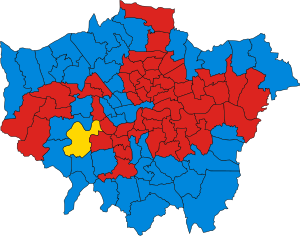Greater London Council election, 1981
|
|
|||||||||||||||||||||||||||||||||
|---|---|---|---|---|---|---|---|---|---|---|---|---|---|---|---|---|---|---|---|---|---|---|---|---|---|---|---|---|---|---|---|---|---|
|
|||||||||||||||||||||||||||||||||
|
92 councillors 47 seats needed for a majority |
|||||||||||||||||||||||||||||||||
|
|||||||||||||||||||||||||||||||||

Results by parliamentary constituency.
|
|||||||||||||||||||||||||||||||||
|
|||||||||||||||||||||||||||||||||
There was an election to the Greater London Council held on 7 May 1981. Councillors were elected to serve until elections in May 1985. Those elections were cancelled and the term was extended until 1 April 1986.
Whilst the moderate leader of the Labour GLC group Andrew McIntosh led the party into the election, and became GLC Leader. Within 24 hours however McIntosh's leadership was toppled by Ken Livingstone; a member of the party's more militant left-wing.
Turnout: 2,250,118 people voted. All parties shown.
This was the last election to the GLC. The Conservative government of Margaret Thatcher took the decision to abolish the council in the mid-1980s. For more information on this see the article, Greater London Council. Following the abolition of the GLC, there was a direct election to the Inner London Education Authority in 1986.
...
Wikipedia
